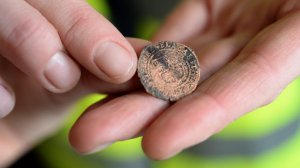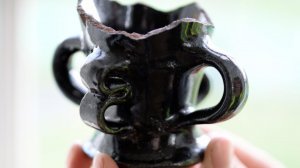What are the luxury goods?
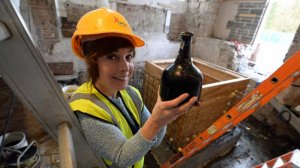 A hoard of 17th century luxury consumer goods was found hidden under the floor of a tower in Dublin’s Rathfarnham Castle. All the floors in the tower had been removed to construct an elevator shaft that would make the space wheelchair accessible (the work was monitored by an archaeologist since the castle is a National Monument). At the bottom of the tower underneath the 18th century stone floor, they discovered a large cache of what may have been garbage to the inhabitants of the castle, but would have been precious treasure to most people in their era and certainly in ours.
A hoard of 17th century luxury consumer goods was found hidden under the floor of a tower in Dublin’s Rathfarnham Castle. All the floors in the tower had been removed to construct an elevator shaft that would make the space wheelchair accessible (the work was monitored by an archaeologist since the castle is a National Monument). At the bottom of the tower underneath the 18th century stone floor, they discovered a large cache of what may have been garbage to the inhabitants of the castle, but would have been precious treasure to most people in their era and certainly in ours.
Because the cache was sealed by the floor, the hiding place had very little air circulating. It was also quite damp and muddy, which helped preserved organic matter as well as delicate artifacts like glass bottles and porcelain.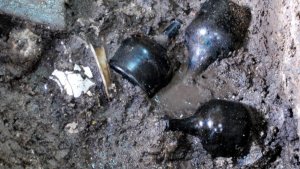 It’s an impressively large collection. Archaeologists recovered them from the mud by the bucketful. The objects may have been hidden deliberately when the castle was under attack (which it was a lot in the mid-17th century), or they may have been set aside for washing and then forgotten about, or simply thrown away. Or maybe some things were stashed with the intention of retrieval while other items were dumped as trash.
It’s an impressively large collection. Archaeologists recovered them from the mud by the bucketful. The objects may have been hidden deliberately when the castle was under attack (which it was a lot in the mid-17th century), or they may have been set aside for washing and then forgotten about, or simply thrown away. Or maybe some things were stashed with the intention of retrieval while other items were dumped as trash.
A number of late 17th century glass wine bottles, all intact, were found, some of which still had their seals, marked with a date stamp of 1688 and initials AL for Adam Loftus. Glass wine bottles only began to be used in 1650, so we’re talking very early survivals here of very fragile material.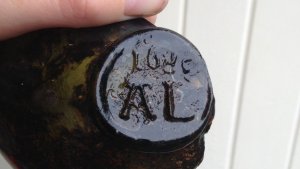 Another rare survival is of an intact crystal drinking glass, about the size and shape of a lipped shot glass. The crystal is much thinner than the wine bottles, so very few of them have made it out of their time without breaking. Then there’s the mysterious corked glass vial that still has liquid inside, possibly a perfume or essential oil. Its contents will be examined in a laboratory.
Another rare survival is of an intact crystal drinking glass, about the size and shape of a lipped shot glass. The crystal is much thinner than the wine bottles, so very few of them have made it out of their time without breaking. Then there’s the mysterious corked glass vial that still has liquid inside, possibly a perfume or essential oil. Its contents will be examined in a laboratory.
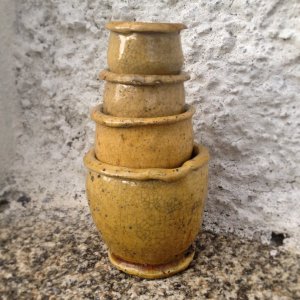 There is a complete set of pottery ointment or cosmetic jars, possibly made in Italy, one of which still has ointment in it. They’re graduated in size so they can stack neatly one inside the other. Porcelain wasn’t produced in England until 1750. Before then, it had to be imported from the far east. The porcelain discovered at Rathfarnham Castle is Chinese. The maker’s mark on the base of one plate identifies it as from the 1660s.
There is a complete set of pottery ointment or cosmetic jars, possibly made in Italy, one of which still has ointment in it. They’re graduated in size so they can stack neatly one inside the other. Porcelain wasn’t produced in England until 1750. Before then, it had to be imported from the far east. The porcelain discovered at Rathfarnham Castle is Chinese. The maker’s mark on the base of one plate identifies it as from the 1660s.
You might also like


|
24 HOUR SALE | Cozy Greens® Backseat Organizer | EXTRA DURABLE, EXTRA SPACIOUS Car Organizer | *FREE BONUS*: eBook on Traveling with Kids | CHARITY-APPROVED | LUXURY GIFT BOX | Acts as Kick Mat, Car Seat Protector and Back Seat Protector | Premium Quality Durable Waterproof Material | Super Secure Strap System™ | Lifetime Satisfaction Guarantee! | Super Spring Sale - 40% OFF Today Baby Product (Cozy Greens)
|

